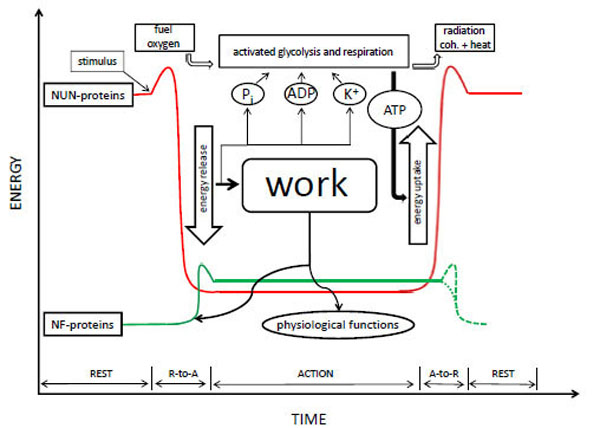Fig. (1) Energy levels of natively unfolded proteins (NUN) (red line) and natively folded proteins (NF) (green line) in the resting-state (R), action-state (A) and during R-to-A and A-to-R phase transitions. The energy level of NUN-proteins relative to that of NF-proteins during the A-state is approximately. For both groups it is somewhere between the levels of the fully unfolded state (see: NUN-proteins during the R-state) and fully folded state (see: NF-proteins during the R-state). The exact values depend on the kind of protein, but the energy difference of the R-to-A transition is always greater for NUN-proteins than for NF-proteins. During the R-state, NUN-proteins are inactive. They are unfolded, polarize cell water and adsorb K+, creating a high-energy low-entropy metastable state. A sufficiently strong stimulus is needed for them to leave their high-energy basin (threshold). NF-proteins are inactive as well during the R-state because they are tightly folded, hiding their reactive centers inside. Slight melting to an intermediate state is needed to expose these centers and make them active. The frame representing glycolysis and respiration points towards the processes that convert fuel, oxygen, ADP and Pi into CO2 , H2O, ATP and radiation (both coherent and waste heat), but is not intended to lie on the energy axis. Energy of entropic origin released during the R-to-A transition of NUN- proteins is used for activation of NF-proteins and for biological work (physiological functions). K+, Pi and ADP liberated during the R-to-A transition of NUN-proteins is thought to activate major rate controlling enzymes of glycolysis and respiration, in agreement with known allosteric mechanisms. So formed new ATP adsorbs to NUN-proteins and causes their A-to-R transition. Subsequent lowering of K+ and ATP activity deactivates glycolysis and respiration. A-to-R deactivation of NF-proteins either needs a small amount of energy to leave their A-state high-energy basin or is a spontaneous process, probably depending on the case. Therefore, both possibilities are drawn with dotted lines.


